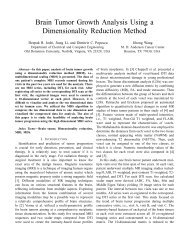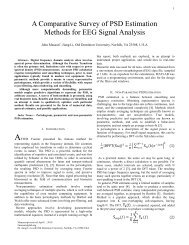Users Guide - the Virginia Modeling, Analysis and Simulation Center
Users Guide - the Virginia Modeling, Analysis and Simulation Center
Users Guide - the Virginia Modeling, Analysis and Simulation Center
You also want an ePaper? Increase the reach of your titles
YUMPU automatically turns print PDFs into web optimized ePapers that Google loves.
Real Time Evacuation Planning Model (RtePM)A Decision Support Tool for Emergency Managers <strong>and</strong> First RespondersBackgroundReal Time Evacuation Planning Model (RtePM – pronounced “route-PM”) was developed in response to<strong>the</strong> emergency management community’s desire to have an easy-to-use tool that quickly estimates <strong>the</strong>time required to evacuate an area in <strong>the</strong> event of natural or man-made disasters such as hurricanes,wildfires, <strong>and</strong> terrorists incidents (e.g. a “dirty bomb”). The main purpose is to enable emergencymanagers <strong>the</strong> opportunity to gain insight form testing various evacuation scenarios thus enablinginformed decision making <strong>and</strong> improved information sharing between federal, state, local, <strong>and</strong> tribal firstresponders <strong>and</strong> all levels of government.RtePM accepts external data such as:TransportationInfrastructureDemographicRtePM uses a color-coded map interface <strong>and</strong> is designed to:collect, process <strong>and</strong> store traffic network <strong>and</strong> behavior model parametersaccept <strong>and</strong> verify parameters specified to generate traffic flow <strong>and</strong> clearance timesgenerate traffic flow information <strong>and</strong> clearance timesmaintain a repository of public <strong>and</strong> private evacuation scenariosinject static data <strong>and</strong> pre-set traffic conditions.Hardware/Software OverviewRtePM runs in a PC environment. The end user application is accessible via any web browser (e.g.Internet Explorer TM , Firefox TM , Safari TM <strong>and</strong> Chrome TM ) with Flash TM plug-in version 10.0 or higherinstalled. No additional installation steps are required.The Real Time Evacuation Planning Model (RtePM) was initially developed by John Hopkins UniversityApplied Physics Laboratory (JHU-APL) as part of <strong>the</strong> U.S. Department of Homel<strong>and</strong> Security (DHS)Science <strong>and</strong> Technology Directorate’s (S&T) Virtual USA (vUSA) initiative. The vUSA initiativeresulted from collaborations between <strong>the</strong> Department of Homel<strong>and</strong> Security, <strong>the</strong> emergency responsecommunity <strong>and</strong> eight states across <strong>the</strong> nation.Under <strong>the</strong> guidance <strong>and</strong> direction of <strong>the</strong> <strong>Virginia</strong> Department of Emergency Management (VDEM),VMASC exp<strong>and</strong>ed on <strong>the</strong> initial work a dynamic mode using r<strong>and</strong>omness (“probabilistic”) to enhancesituation awareness, capability <strong>and</strong> flexibility. Additional features have been added. Independentverification <strong>and</strong> validation testing has been completed <strong>and</strong> identified short comings.Point of Contact (POC)The email address rtepm@odu.edu reaches a common email mailbox at VMASC. Email received at thisaddress will be routed internally to <strong>the</strong> appropriate POC for information or action as indicated.Accessing RtePMTo access <strong>the</strong> RtePM tool, type into <strong>the</strong> address bar of your web browser, <strong>the</strong> URLhttp://rtepm.vmasc.odu.edu/RTEPM/ <strong>and</strong> press enter. Once <strong>the</strong> program has loaded completely, youshould see an image of <strong>the</strong> U.S. map with <strong>the</strong> pop-up overlay shown in Figure 1.1
















